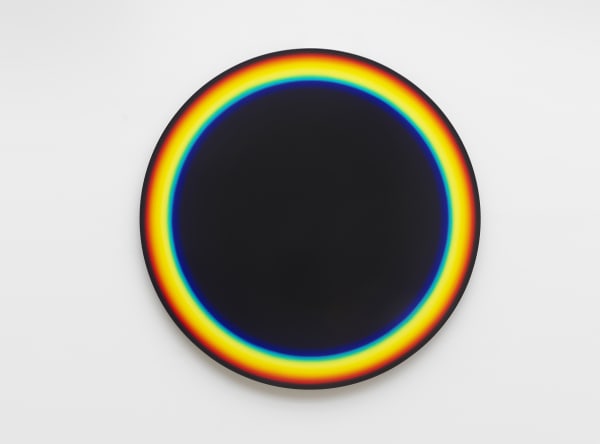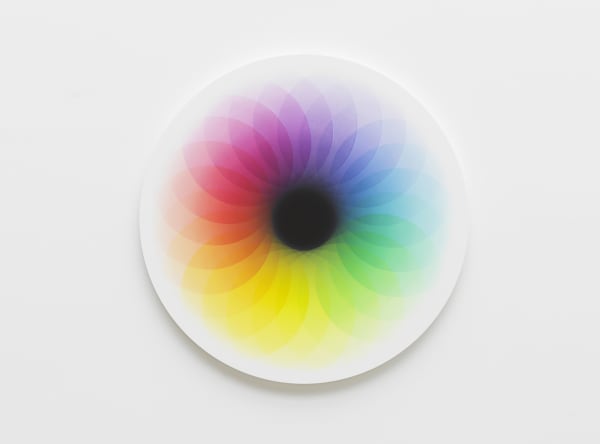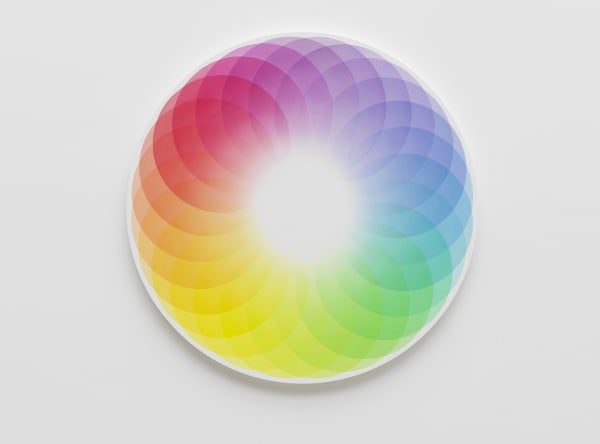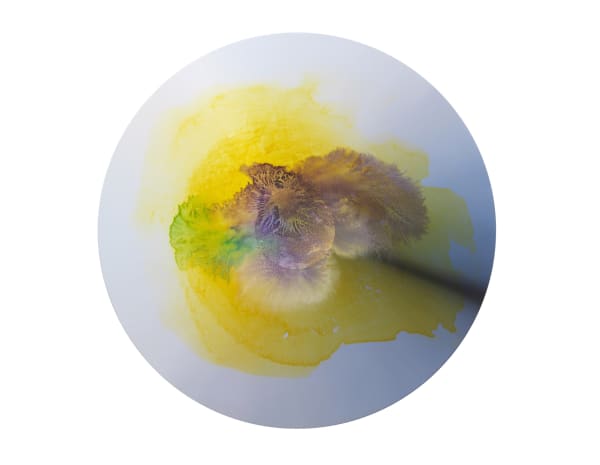Olafur Eliasson: Your light spectrum and presence: Tanya Bonakdar Gallery, Los Angeles
Tanya Bonakdar Gallery is pleased to present Olafur Eliasson’s Your light spectrum and presence on view in Los Angeles from February 5 – April 2, 2022. In this exhibition, eleven circular paintings, created between 2012 and 2021, represent Eliasson’s long-standing investigation with light, color and the ways we perceive and interact with our surroundings. Known collectively as the ‘colour experiment’ series and numbered sequentially, these circular canvases strive to challenge our expectations and encourage our eyes to stay in constant motion.
Several paintings in Your light spectrum and presence feature the bright spectrum of color seen in the natural phenomena of a rainbow, a recurring motif throughout Eliasson’s practice.
‘In the hurly-burly of everyday existence, the generosity of the rainbow lies in its unexpected appearance. It is a small miracle when the position of the sun, adequate weather conditions, and your eyes – otherwise focused on your busy life – align to create a rainbow. This may allow you to pause to celebrate the fleeting moment of trajectories meeting up. It is like nature offering a surprise party, while allowing us the pleasure of being a co-host.’ – Olafur Eliasson
Eliasson began his ongoing ‘color experiment’ series in 2009, inspired by the idea of producing a new, comprehensive color theory that would comprise all the visible colors of the prism. He began by working with a color chemist in an attempt to mix an exact tone of paint for each nanometer of light in the spectrum, which ranges in frequency from approximately 390 to 700 nanometers.
Since those initial experiments, Eliasson has created compositions that range from simple explorations of the spectrum, such as commissions for the Israel Museum in Jerusalem and the MCA Chicago, to more complex efforts to capture the light of a specific moment, in a specific place. Light measurements: Reykjavik, 20 March 2011, 13:00 GMT (2012), represents the latter, converting the specific mix of color in the daylight as measured in Reykjavik on March 20, 2011, at 1 pm. The color palette is based on the wavelengths of light visible at the time, and the composition of the painting reflects the proportion of the various hues measured. The result is a unique asymmetrical pattern of color that represents the daylight throughout the course of that particular moment. Studying these differences in light suggests our perception of the world is highly individual, based on our locations, our experiences and our unique vantage points.
Eliasson has also taken inspiration from the work of JMW Turner, Caspar David Friedrich, and Claude Monet, all masters of landscape painting who were radicals in their time for their stylistic and atmospheric representation of landscape. Eliasson dematerializes the represented landscapes of these artists by analyzing the light and color levels in specific paintings. While working on Colour experiment no. 87, based on Caspar David Friedrich’s Der Wanderer über dem Nebelmeer (1818), Eliasson analyzed the color, light, hue, saturation and spectrographic color division to create the painting’s seamless gradients of color, painted layer by layer by hand over three years.
In a related series, Eliasson uses the same method to examine the colors found in a photograph taken by the artist in 2012 in Iceland. Then Eliasson places a piece of glacial ice, harvested from the waters of the Nuup Kangerlua fjord in Greenland, at the center of the canvas. As the ice melts, the artist adds small quantities of pure pigment, which are carried across the canvas to create a new landscape of color fields. Formless yellow, green, and purple explosions spread out from the center of the canvas, contrasting starkly with the even background. Metaphorically, the change in state of the ice, and its interaction with the color pigments, reflects the infinitely transitory nature of natural phenomena, as well as both the beauty and fragility of the landscape.
In his latest body of works, Eliasson addresses the notion of light in darkness. The background of the painting is black, creating a hypothetical and unnatural isolation of a rainbow encompassed by nothingness. However, the void in the center is not completely absent of visible light, instead the viewer recognizes various subtle shades of deep blues and purples, slowly bringing the eye to the bordering spectrum of color. Scaled approximately to the proportions of a human body, the paintings allow the viewer to be surrounded by a glorious rainbow.
‘Geometrically speaking, a rainbow is actually a circle. If the earth were not in the way, if there were no horizon blocking your view, you would see the whole round rainbow as a perfect circle wrapping around you, with your eye at its center. Two people standing even a few meters apart will perceive two different rainbows, each oriented to their own perspective. We can never see the other person’s rainbow.
You could almost say that a rainbow, as an ephemeral phenomenon, confirms my existence. If there is a rainbow, then there must be an I who is seeing it.’ – Olafur Eliasson
All installation images above: Photo by Jeff McLane
-
 Colour experiment no. 101
Colour experiment no. 101 -
 Colour experiment no. 92
Colour experiment no. 92 -
 Colour experiment no. 94
Colour experiment no. 94 -
 Colour experiment no. 97 (Black with rainbow, 2019)
Colour experiment no. 97 (Black with rainbow, 2019) -
 Colour experiment no. 105
Colour experiment no. 105 -
 Colour experiment no. 113
Colour experiment no. 113 -
 Colour experiment no. 108
Colour experiment no. 108 -
 Colour experiment no. 106
Colour experiment no. 106 -
 Colour experiment no. 87
Colour experiment no. 87 -
 Light measurements: Reykjavik, 20 March 2011, 13:00 GMT
Light measurements: Reykjavik, 20 March 2011, 13:00 GMT -
 Light measurements: Reykjavik, 20 March 2011, 19:25 GMT
Light measurements: Reykjavik, 20 March 2011, 19:25 GMT




















